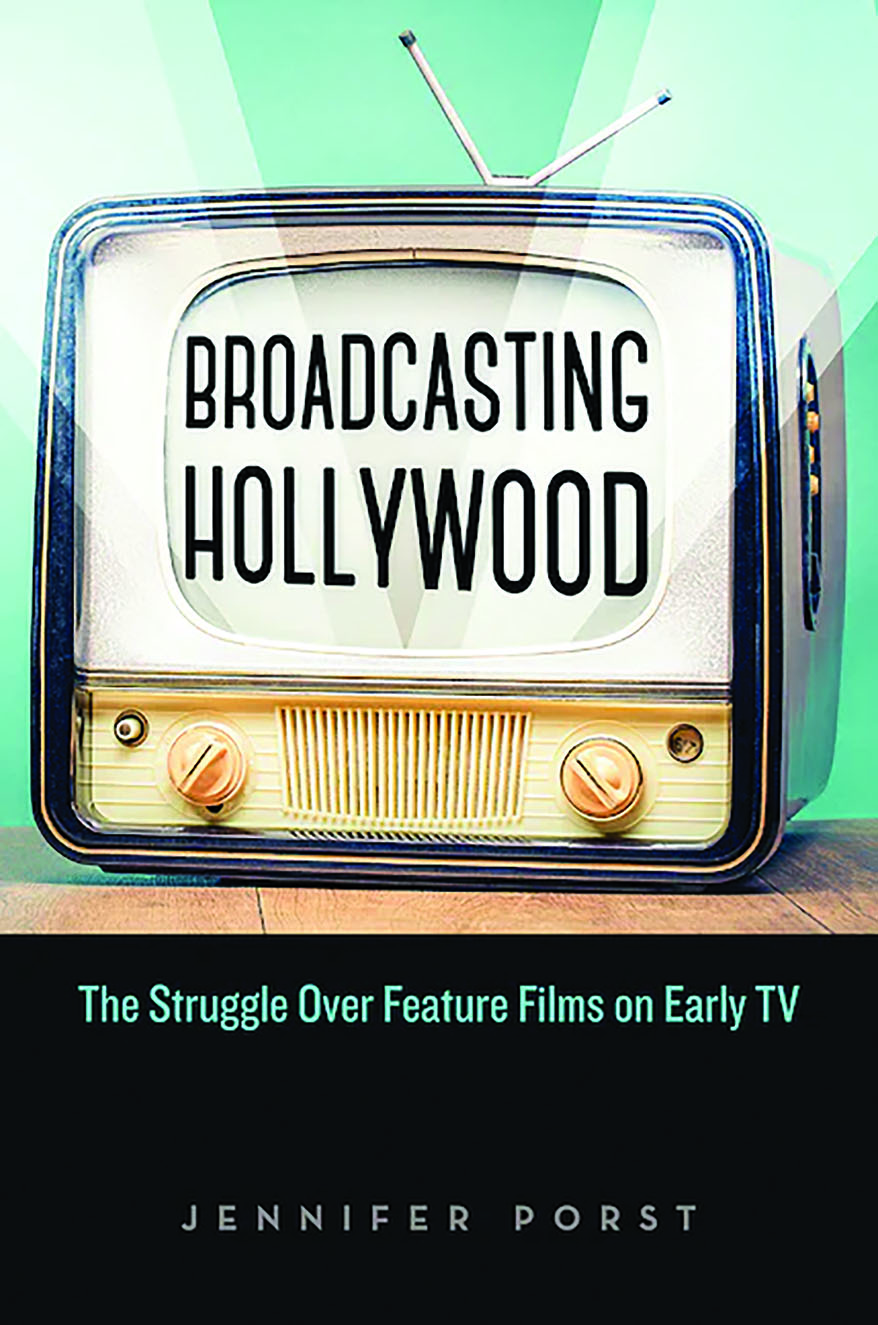In Broadcasting Hollywood, author Jennifer Porst argues that a “complex combination of industrial, social, legal, and governmental forces” brought about the delayed release of Hollywood studio films to television stations for broadcast beginning in 1956, disputing scholars’ “long-held assumptions” that the motion picture industry’s apathy and hostility toward the new medium were to blame.1 While Porst acknowledges a crowded field of scholars who have addressed the interrelation between the motion picture and television industries during the latter’s boom in the 1950s, she asserts her own intervention in the “tumultuous and complex” relationship between the two industries by focusing on the licensing and sale of Hollywood films to television, a struggle that arose from “many different industrial agendas involved in the negotiations.”2 Noting the influence of William Uricchio and Mark Williams, Porst aims to shift the conceptual focus from isolated studies of mediums to what Williams calls “intermedial studies,” examining “relations between and across media at significant historical junctures.”3 This approach challenges us to rethink the critical historical junction of the film and television industries in the 1950s in relation to the contemporary convergence and disruption of media industries in our digital age.
Porst constructs her theoretical framework using a media industries studies approach, building on the work of Hilmes, Holt, Meehan, Gomery, and Hesmondhalgh, while also folding in important terminology from economic theorists such as Schumpter, Lobel, Christensen, and Currah. Focusing on the industrial, economic, and regulatory forces involved in the plight of bringing Hollywood films to television, Broadcasting Hollywood incorporates extensive primary research, principally the documentation and testimony from legal and regulatory proceedings that shaped the conditions under which studio films could be aired. Use of these first-person testimonies allows Porst to push back on the biases and inaccuracies uncovered in trade publications and secondary research and to incorporate the voices of those most directly involved in the struggle over broadcasting Hollywood films on television. Porst weaves together her findings from thousands of pages of legal transcripts to chart Hollywood’s reaction to television’s disruption and to describe how that reaction can inform our understanding of the current media landscape.
Regulatory bodies such as the FCC and Hollywood industrial organizations were among the earliest institutions to react to the disruptive force of television. Chapter 1 documents how these reactions shaped the television industry and altered the Hollywood motion picture studios’ strategies of how best to engage, if at all, with finding a home for their films on the nascent medium. Porst details how the 1948 FCC freeze on new or pending applications for the construction of TV broadcast stations coincided with a decline in box office income for the Hollywood studios, transitioning the motion picture industry “from a period of dominance and stability to a period of profound change and uncertainty.”4 Despite traditional discourse on Hollywood’s early skepticism or hostility toward the television industry, Porst contends the film industry actively explored ways to become involved in television, even after the FCC made it clear the studios’ pursuit of their own television stations would not be realized without a fight. Existing television stations needed content and lots of it, and Hollywood films were an ideal source of programming. While the major studios held off making deals for their films to television, independent and foreign producers jumped into the fray, becoming the primary early source for films on television. These films proved incredibly successful on TV, earning some of the new medium’s highest ratings, but this new source of programming came with extra hurdles, such as ensuring suitable content for television and overcoming the quality limitations of broadcasting 16 mm projection prints. Meanwhile, the major studios took a more cautious approach, waiting to see how many of the regulatory proceedings played out with organizations such as the National Association of Broadcasters (NAB), the Motion Picture Producers and Distributors of America (MPPDA), and the Council of Motion Picture Organizations (COMPO). Despite this caution, studios such as Columbia and Twentieth Century Fox still actively prepared for the sale of their films to television, hoping their planning would result in deals that would realize their maximum potential.
Having firmly established the relevant industrial stakeholders and regulatory bodies, Porst devotes Chapter 2 to exploring the ways in which television disrupted audience consumption. With the decline in theater attendance in the late 1940s, industry executives and organizational heads continued to point to television as the culprit, even though suburbanization and the Paramount legal decision forcing studios to divest from their exhibition chains were eroding box office numbers. Eager to understand the extent to which television was causing the industry’s decline, exhibitors conducted audience surveys with varying degrees of effectiveness, mostly causing more confusion and precarity. Fueled by this uncertainty, the Theater Owners of America (TOA) started a tireless campaign to ensure studios, producers, and distributors understood the potential threat to theaters of selling their films for television broadcast. Porst also recounts how some theater owners explored diversifying into television, either through station ownership or theater television. While theaters did not have the same FCC and DOJ restrictions as studios against owning stations, movie house chains largely avoided the possibility of expanding into television, hoping instead that new strategic trends would attract moviegoers back to theaters, including the increasing use of color film, widescreen technologies, and the rerelease or reissue of hit films back in theaters.
The big studios didn’t withhold their films from television solely as a strategy to protect theaters or ensure maximum box office revenues. Chapter 3 shows us that another factor in the studios’ reticence was the complicated issue of sorting out rights, residuals, contracts, and union membership. Porst documents the early debates and struggles of different Hollywood unions and guilds with studios and production companies over how television residual payments would be structured for Hollywood labor belonging to organizations such as the Screen Actors Guild (SAG), the Directors Guild of America (DGA), the Writers Guild of America (WGA), and the American Federation of Musicians (AFM). Through her extensive research, the author lays out a particularly fascinating account of the ways in which the AFM frequently trailblazed labor negotiation efforts, providing other unions and guilds with a blueprint from which to settle terms during their negotiation efforts. When contract negotiations turned to residuals for the sale of films to television, Porst declares, “the AFM was on the cutting edge of fighting for residual payments and ultimately forged the structure for residual payments that is still in use today.”5 Despite these pioneering efforts, negotiations for the other unions and guilds were slow-moving, eventually reaching resolution on most of the major sticking points by 1960.
Chapters 4 and 5 delve into specific lawsuits and legal challenges that helped shape the relationship between film and television, paying special attention to how these legal outcomes restricted how the two mediums could reciprocally affect each other. Chapter 4 focuses on the specific case studies of Gene Autry and Roy Rogers, both of whom sued their employer, Republic Studios, to block it from releasing their films to television. Legal teams for the two stars separately made the same argument, that television was a commercial medium, and thus their films on television constituted commercial advertising, which their contracts did not include. After a series of hearings and appeals, Republic ultimately prevailed and was allowed to sell the Autry and Rogers films to television, but the two cases effectively halted the major studios in joining Republic in selling their films to television, as they awaited the rulings before deciding how to proceed. Chapter 5 looks at two antitrust cases, U.S. v. Paramount Pictures and U.S. v. Twentieth Century-Fox. Porst asserts that “antitrust law played one of the most significant roles in the struggle over feature films on television,” adding these two cases “had the power to effect massive industrial change with both hoped for and unintended consequences for every aspect of the industry.”6
The floodgates did eventually open for the sale of films to television, but Porst touches on some of the obstacles that remained, in addition to how the studios were able to maximize their licensing and sales to obtain top dollar from their new revenue stream. In Chapter 6, Porst identifies how the number of distribution channels, the total number of films available for broadcast, and the prices for said films all swung upward, as more studios released films to the television market and as the use of films on television expanded from local independent stations to the major networks. Studios such as RKO, Fox, and Columbia were the first dominoes to fall, gaining valuable negotiating experience and much-needed income from their early deals. The surge of feature films on television caused some unexpected consequences for the studios, which were now forced to “shoot for the box”: keeping contrast low, isolating important action to one section of the frame, and eventually shooting almost entirely on color, as the networks and television manufacturers made the switch to “full-color.” This increase in filmed content also meant stations needed to upgrade some of their equipment, as the 16 mm equipment many of the stations used to broadcast films on television, in addition to the inferior prints, exacerbated the contrast and quality issues that plagued early television. Porst gives detailed examples of how technical organizations such as the American Society of Cinematographers (ASC) worked to establish technical standards for both production and broadcasting to ensure the best quality presentation on television.
By establishing television as a disruptive force in Broadcasting Hollywood, Jennifer Porst draws comparisons between the effects of television on the film industry in the 1950s and the effects of digital media proliferation on the legacy media industries beginning in the 1990s, observing, “It appeared as though the existing titans of media had their heads in the sand when it came to digital technologies, and when they finally stole a look, it was too late.”7 Porst concludes history largely repeated itself, and while oligopolies are generally averse to adapting to disruption and its resulting negative effects on their bottom line, Porst argues they need to anticipate it and evolve, particularly as media industries increasingly shift to a global landscape. While Broadcasting Hollywood does initially cover some familiar territory, Porst creates the most comprehensive account to date of this fascinating collision between film and television over the sale of film rights, producing insightful analysis based on her exhaustive research, and confronting her ultimate conclusion, “that media studies have arbitrarily kept film, television, and digital media studies separate for too long, when, in reality, the histories of film and television are intricately and essentially interwoven.”8
Notes
- Jennifer Porst, Broadcasting Hollywood: The Struggle over Feature Films on Early TV (New Brunswick: Rutgers University Press, 2021), 3. ⮭
- Ibid., 3, 5. ⮭
- Ibid., 2. ⮭
- Ibid., 22. ⮭
- Ibid., 15. ⮭
- Ibid., 16, 121. ⮭
- Ibid., 1. ⮭
- Ibid., 182. ⮭
Casey Walker is a PhD student in the Department of Radio-Television-Film at The University of Texas at Austin. His research currently focuses on cinematographic labor in the Hollywood studio system, exploring how studio camera departments, trade organizations, World War II photography units, and early television production crews served as exchanges for cultural capital during the studios’ era of dominance. He also examines how these groups, their departmental heads, and their specialized technicians accumulated social capital while reinforcing the homogenization of these technical departments and organizations.



